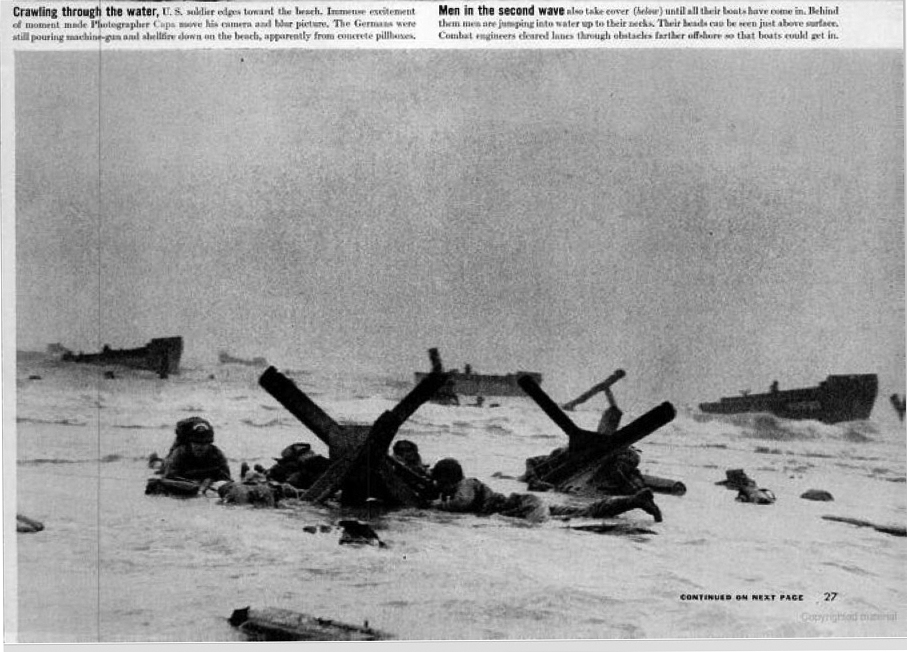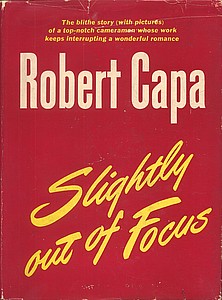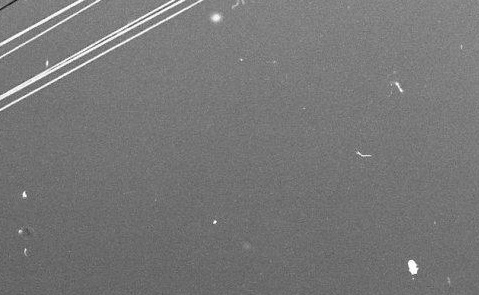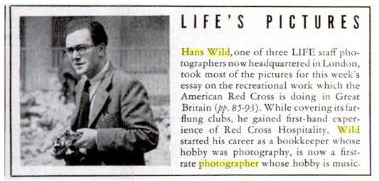In his unauthorized, workmanlike 2003 biography Blood and Champagne: The Life and Times of Robert Capa, Alex Kershaw, describing the motives behind the founding of Magnum Photos, wrote as follows:
“Since 1945, Capa had been active in the American Society of Magazine Photographers. He had eloquently argued that freelancers needed to push hard for some measure of protection from exploitative corporations such as Life, which had not only spoilt his most important story but then tried to cover up its responsibility by blaming Capa himself. Photographers also needed to gain as much control as feasible over the context of their work: in every article bearing his pictures for Life, his work had been captioned to support Henry Luce’s worldview. Last and most crucial, it was imperative that photographers gain copyright on pictures could have immense future value, such as his shots of D-Day.” (p. 179)
 Kershaw gives no specific source for this account of Capa’s comments at ASMP meetings (the organization was founded in the fall of 1944), and when queried via email could only point me toward John Morris’s 1998 memoir Get the Picture: A Personal History of Photojournalism and Russell Miller’s Magnum: Fifty Years at the Front Line of History, published in 1999. Yet I found this in neither of those sources. Perhaps Kershaw read it elsewhere, or extrapolated.
Kershaw gives no specific source for this account of Capa’s comments at ASMP meetings (the organization was founded in the fall of 1944), and when queried via email could only point me toward John Morris’s 1998 memoir Get the Picture: A Personal History of Photojournalism and Russell Miller’s Magnum: Fifty Years at the Front Line of History, published in 1999. Yet I found this in neither of those sources. Perhaps Kershaw read it elsewhere, or extrapolated.
Retaining copyright and subsidiary rights (rather than “gaining” those, as Kershaw inaccurately puts it) proves central to survival as a freelance in any medium, as I can testify from personal experience. Capa’s introduction of that idea to non-staff photographers proved a major contribution. And control of contextualizing material such as captions remains a desideratum for photojournalists, if not always feasible editorially.
With that said, taking Kershaw’s account at face value, given what we know now, and what we know Capa knew in mid-1944 about his meager D-Day reportage and the supposed fate of his negatives, how exactly did LIFE “spoil his most important story [and] then [try] to cover up its responsibility by blaming Capa himself?” By contextualizing them with a less-than-flattering narrative rationalizing their mediocre quality and meager quantity, when Capa had offered no explanation himself? By captioning the images in a way that displeased him, when, quite unprofessionally, he had provided John Morris with no captions whatsoever — resulting, not incidentally, in 70 years’ misreading of the actions of some of the troops shown in his pictures?
If Capa actually made these complaints at early ASMP meetings, they seem intended at least in part to establish as fact — through oral transmission and subsequent circulation via the profession’s rumor mill — the fiction of the London darkroom disaster. Yet the accumulated evidence suggests that the exact nature of this invented catastrophe remained unspecified at that point.
•
In the event, in mid-April of 1947 Capa — along with Henri Cartier-Bresson, George Rodger, and David Seymour (“Chim”) — founded Magnum. By then Capa had already left his staff position at LIFE to go freelance once again. He had also completed and submitted to his publisher, Henry Holt, the overdue manuscript for what the International Center of Photography took to referring to (until recently) as “his autobiographical novel,” Slightly Out of Focus. In that volume, published in fall 1947, Capa publicly and on the record put his stamp on the melted-emulsion darkroom-disaster fable, making it the official version that he — and Morris, and Magnum — would have to endorse and repeat thenceforth. Which they have done, faithfully, until John Morris reluctantly began his recantation and started hedging his bet in the summer of 2014. So, joined at the hip, that tall tale and Magnum Photos share the same birthday, or at least the same birth year.
By 1947 John Morris, Capa’s picture editor at LIFE on D-Day and his close friend, had left LIFE for the Ladies’ Home Journal, in which role he became Magnum’s most lucrative client from the agency’s inception through the next five years. In the process, Morris developed and/or deepened his personal and professional connections to all Magnum’s members and staff. At Capa’s invitation, Morris became Magnum’s first executive director in January 1953. (His actual title, devised by Capa: International Executive Editor.)
By the time Morris came on board at Magnum, then, the emulsion-melt darkroom-disaster that (I believe) he’d cooked up on the night of June 7, 1944 to protect Capa, LIFE, and himself had become a matter of public record. Capa’s authentication of it in his book wove it inextricably into the legend about himself that Capa cultivated, into the standard account of LIFE‘s D-Day coverage, and into the story of Magnum’s inception.
I’ve found no post-1947 publication by or interview with Capa in which he repeats that D-Day fable. Perhaps he didn’t need to; once affirmed in his own book it had legs of its own, and we know that as a gifted raconteur he transmitted it anecdotally; director Sam Fuller and actress Ingrid Bergman both got it straight from the horse’s mouth, reiterating it verbatim in their eventual autobiographies. Surely others heard it from him in conversation as well.
Exactly when Morris began to tell this story himself, in print and public appearances as well as in private, remains unclear. It seems safe to assume that its public debut in Capa’s fanciful memoir created a demand for it; you can dine out for a lifetime on a story like that. Morris has said that it’s his most requested story. No one else identified as present that night — darkroom chief “Braddy” Bradshaw, LIFE contract photographer Hans Wild, “darkroom lad” Denis Banks, “tea boy” Larry Burrows — ever went on record confirming this account, making Morris the lone eyewitness. Consequently, he owns this story; all references to it defer to his version, even if they cite Capa’s secondhand retelling.
Capa died in Vietnam in May 1954, less than 18 months after Morris had taken on the directorship of Magnum. Capa’s younger brother Cornell, comfortable until then in a staff position at LIFE, left shortly after Robert’s death to join Magnum, in part to help preserve his elder sibling’s archive and legacy. Cornell Capa became acting president of Magnum in 1957. Morris left in January 1962; thus he and Cornell Capa worked closely together for five years. By then the Robert Capa legend, including the D-Day myth, had consolidated, becoming the meme that we have today.
Dust in the Wind
What role has Magnum played in all this? First and foremost, they have engaged in a conspiracy of silence. Magnum is, after all, a photographers’ collective. John Morris may claim — truthfully, I’m now convinced — that he knows nothing about the processing of film, never hung out in any darkroom (including LIFE‘s and Magnum’s) on a slow day to watch the processing of film, never inquired as to why the various types and qualities of negatives he handled looked the way they did, never listened to any photographers talking about their craft. But no Magnum photographer can pretend to such ignorance.
Every single member of Magnum, from the agency’s beginning through the present, along with everyone who has ever printed for them, has hands-on experience with the processing of black & white film. They have spent time in private darkrooms, photo-school darkrooms, commercial darkrooms, the darkrooms of various publications, the darkrooms of their own custom printers. And they know now, as they’ve always known, that the doors of the film-drying cabinet in LIFE‘s London darkroom were assuredly not (pace John Morris) “normally kept open.” Because any film-drying cabinet has as its primary function keeping dust, hair, small flying insects, and other airborne matter away from the sticky surface of damp film emulsion while it dries. This requires doors — doors that get opened only to insert and remove film strips, or to dry out after a developing session or a wipe-down, but otherwise get kept shut.
What problem does dust and such cause when it adheres to a negative? Even a tiny speck of opaque matter will prevent light from penetrating the negative at that point, resulting in a visually distracting bright white dot at the corresponding location on a print. In analog photography, each such flaw requires “spotting,” a tedious process involving the manual application of a special type of tinted ink with a fine brush to camouflage the damage. This takes patience, and time; even the most skillful hand cannot always do so without leaving a trace. Hence the preventive precaution of film-drying cabinets with doors kept closed.
That would hold especially true in a weekly news magazine’s darkroom in 1944 wartime London, pre-air conditioning and air filtration — a bustling metropolis still subject to periodic Nazi bombing, militarized and hectic with invasion-prep traffic, the city air aswirl with dust, ash, and other particulate matter. Only an incompetent would run the darkroom of the world’s major picture magazine with drying-cabinet doors open under those circumstances.
And because sensible darkroom practice worldwide includes closing the doors of film-drying cabinets to keep dust off the negatives, no such cabinet — whether improvised, like the one in LIFE‘s London darkroom (according to Morris), or manufactured for that professional purpose — incorporates a heating element powerful enough to damage film while drying with the doors shut, a process that takes only a few minutes. If it did, we’d have frequent references in the literature to accidental but catastrophic heat damage to other important films while drying. To the contrary, we have none; the Capa incident is unique in the literature, the only recorded loss of crucial, historic film to excessive heat while drying.
Furthermore, it is simply inconceivable that, with five darkroom staffers on hand to take care of Capa’s precious films, darkroom chief “Braddy” Bradshaw assigned the task of developing them to the least experienced among his crew, 15-year-old Denis Banks, leaving him unsupervised, and that, with John Morris screaming for prints and everyone on tenterhooks, they all overlooked the fact that Banks had violated what Morris claims was darkroom protocol for the drying cabinet and didn’t bother to check on the film until too late.
No competent darkroom manager — and LIFE in 1944 could afford to hire the best, and no doubt did — would allow as a standing condition in his domain a situation in which a moment’s inadvertence could jeopardize and even destroy invaluable films, such as a drying cabinet that could overheat so quickly and intensely as to damage film emulsion.
Finally, LIFE had not one but two experienced darkroom managers on hand that night: Bradshaw and Hans Wild (Bradshaw’s predecessor in that role). They both knew that the emulsion of black & white film did not melt when exposed briefly to the heat of their film-drying cabinet. What possible motive could they have had to allow young Denis Banks to think that he’d ruined irreplaceable historic negatives, or to allow him to ignorantly delude Morris into believing that he’d done so?
This story simply falls apart when you examine it closely. The implausible claptrap about the closed doors of the film-drying cabinet causing the destruction of Capa’s films sits at the very heart of Morris’s confabulation of that night’s events; it is one-half of the lie he clings to and asks us to believe while still protesting his innocence. Magnum’s members have gone along with it for almost 70 years. I’ll address the second half of that falsehood — which Magnum’s members have also tacitly endorsed for seven decades — in my next post.
•
(For an index of links to all posts in this series, click here.)
•
This post supported by a donation from Martin Magid.















Leave a Comment